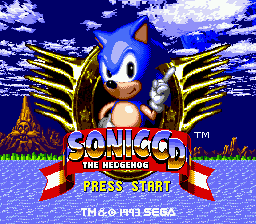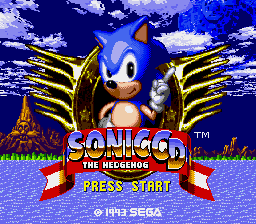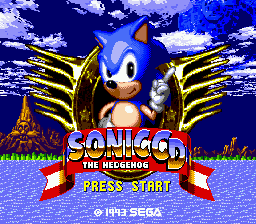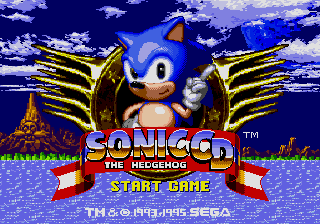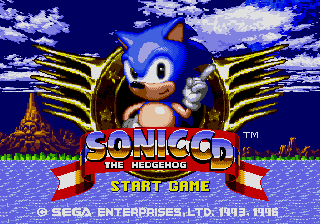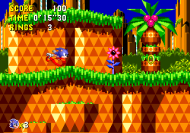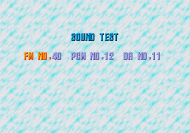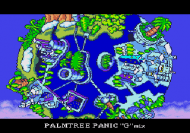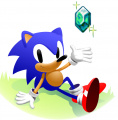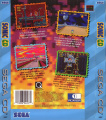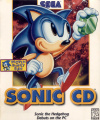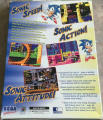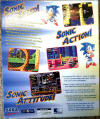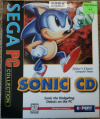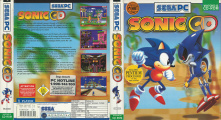Sonic the Hedgehog CD
From Sonic Retro
(Redirected from Sonic CD)
- For the 2011 remake, see Sonic the Hedgehog CD (2011).
| Sonic the Hedgehog CD | |||||||||||||||||||||||||||||||||||||||||||||||||||||||||||||||||||||||||||||||||||||||||||||||||||||||||||||||||||
|---|---|---|---|---|---|---|---|---|---|---|---|---|---|---|---|---|---|---|---|---|---|---|---|---|---|---|---|---|---|---|---|---|---|---|---|---|---|---|---|---|---|---|---|---|---|---|---|---|---|---|---|---|---|---|---|---|---|---|---|---|---|---|---|---|---|---|---|---|---|---|---|---|---|---|---|---|---|---|---|---|---|---|---|---|---|---|---|---|---|---|---|---|---|---|---|---|---|---|---|---|---|---|---|---|---|---|---|---|---|---|---|---|---|---|---|
| | |||||||||||||||||||||||||||||||||||||||||||||||||||||||||||||||||||||||||||||||||||||||||||||||||||||||||||||||||||
| System(s): Sega Mega-CD, Windows PC | |||||||||||||||||||||||||||||||||||||||||||||||||||||||||||||||||||||||||||||||||||||||||||||||||||||||||||||||||||
| Publisher: Sega Sega PC Expert Software (US) Swing! Entertainment (Germany) | |||||||||||||||||||||||||||||||||||||||||||||||||||||||||||||||||||||||||||||||||||||||||||||||||||||||||||||||||||
| Developer: Sega CS3[1][2] Sega CS1 (early development?[3]) H.I.C. (programming) Toei Animation (animation) Sonic Team Sega PC Shout! Design Works (programming) CRI (graphics data conversion & additional art) Cube (music and sound effect recomposition) Sega Digital Studio (animation movie) | |||||||||||||||||||||||||||||||||||||||||||||||||||||||||||||||||||||||||||||||||||||||||||||||||||||||||||||||||||
| Distributor: SKC Softland (KR) Worldwise Enterprise (TW) Media Master International (TW) | |||||||||||||||||||||||||||||||||||||||||||||||||||||||||||||||||||||||||||||||||||||||||||||||||||||||||||||||||||
| Peripherals supported: CD BackUp RAM Cart | |||||||||||||||||||||||||||||||||||||||||||||||||||||||||||||||||||||||||||||||||||||||||||||||||||||||||||||||||||
| Genre: Action[4] | |||||||||||||||||||||||||||||||||||||||||||||||||||||||||||||||||||||||||||||||||||||||||||||||||||||||||||||||||||
| Number of players: 1 | |||||||||||||||||||||||||||||||||||||||||||||||||||||||||||||||||||||||||||||||||||||||||||||||||||||||||||||||||||
|
Sonic the Hedgehog CD (ソニック・ザ・ヘッジホッグCD) is the first and only Sonic the Hedgehog title released for the Mega-CD add-on used with the Sega Mega Drive console. Developed separately from the sequels done by the Sega Technical Institute, the game was directed by the creator of Sonic, Naoto Ohshima.
Introducing such fan favorites as Amy Rose and Metal Sonic, it has become something of a cult classic, partly because of its release on the expensive add-on that most Mega Drive owners did not have access to, and partly because of its visual style and gameplay that makes it stand out from the other classic games in the series.
Contents
Story
For one month out of the year, an enigmatic miniature celestial body called the Little Planet appears over the enormous Never Lake. Both a place of beauty and wonder, it is said that time moves freely on the planet, and that entire sceneries can change in a blink of an eye, all because of the mysterious secret they hold, the seven mystical Time Stones. It is said that whoever possesses these gems will be able to freely move through time, just as the surface of Little Planet does.
Almost expectantly, the news of such a place grabs the attention of Dr. Eggman, the mad genius who desires nothing more than world domination. Journeying to the Little Planet, Eggman immediately begins turning it into his personal fortress, littering the landscape with his mechanical genius. Powered not by animals but by the essence of flowers, he sets his army to tear the planet apart so he can claim the Time Stones for himself.
As fate would have it, Sonic the Hedgehog, the speedy blue blur who has stopped Eggman time and again, was also intending on seeing the small, miracle planet, oblivious to the fact Eggman had already beaten him to the locale. Learning of the news that Sonic was fast approaching, Eggman only smiled, excited to put his latest and greatest invention up against the hedgehog, confident that he would finally be able to defeat his arch enemy once and for all...
Arriving at Never Lake, Sonic immediately could tell that something was amiss. The Little Planet, which should have been a shining example of natural beauty, was instead covered in a mechanical wasteland, visible even from the distance he was at. Seeing that the small planet was tethered to the Earth's surface, Sonic examined the mountainside the chain was connected to, recognizing the visage etched into its surface. With the image of Eggman's face smiling at him, Sonic confirmed what he was already expecting. Jumping onto the chain, Sonic quickly darted up, speeding towards the surface of the Little Planet and preparing to face Eggman once more.
What might have otherwise been another simple fight against the genius scientist was immediately complicated by another layer that Sonic only discovered once he set foot in Palmtree Panic. Amy Rose, Sonic's biggest fan and self-proclaimed girlfriend, had been doing what she often did, playing around with her tarot cards in an attempt to look into the future. The cards telling her that she had a "destined encounter" with Sonic at Never Lake, she journeyed herself to the Little Planet, immediately becoming excited once she spotted her blue idol.
None too pleased with Amy's appearance, she may have been nothing more than a slight bother if not for Eggman's intervention. At the outskirts of Collision Chaos, Sonic received his first glimpse of Metal Sonic, a robotic duplicate that Eggman created specifically to counter Sonic's every move. In the blink of an eye, the robot snatched up Amy, disappearing into the horizon. Now Sonic must not only stop Dr. Eggman and grab the Time Stones before he does, but save Amy Rose from the clutches of his metallic doppelgänger.
"No problem! With a little courage, you can do anything!"
According to Yasushi Yamaguchi, Sonic CD's story takes place between Sonic the Hedgehog and Sonic the Hedgehog 2.[13][14] This was confirmed later in the Sonic the Hedgehog Encyclo-speed-ia and Sonic Origins.
Gameplay
Though some of the terminology is switched around, the basic premise of the classic Sonic the Hedgehog titles remain: to traverse a series of obstacles and enemies within a given level under ten minutes, generally from left to right. While loop-de-loops, spikes, Springs, and an assortment of other standard Sonic elements return, there are enough unique elements to this installment of the platformer series which makes it stand out from the quartet released on the Sega Mega Drive. Instead of the usual Zone and Act nomenclature, stages are referred to as Rounds which are split into three Zones; the third Zone is significantly shorter than the other two, but features a boss encounter with Dr. Eggman at the end. While Sonic the Hedgehog and its Mega Drive sequels had very straightforward battles with the doctor, the fights with him in CD are varied, taking fewer hits but being significantly more complicated and difficult.
The control scheme for Sonic remains largely unchanged, the same momentum-based gameplay preserved under the hood. Pressing one of the buttons on the Control Pad once again allows Sonic to curl up into his Spin Attack, attacking an enemy from any angle as long as spikes or some other dangerous projectile is not in the way. Pressing ![]() on the Control Pad while running also allows Sonic to curl up in his Spin Attack, the roll lasting as long as momentum will allow. In addition, Sonic possesses his Spin Dash move from Sonic the Hedgehog 2, albeit it works and looks differently. Sonic's Spin Dash in this game uses the standard rolling animation.
on the Control Pad while running also allows Sonic to curl up in his Spin Attack, the roll lasting as long as momentum will allow. In addition, Sonic possesses his Spin Dash move from Sonic the Hedgehog 2, albeit it works and looks differently. Sonic's Spin Dash in this game uses the standard rolling animation.
In Sonic 2 and nearly every game that features the Spin Dash, all the player must do is press ![]() and tap either
and tap either ![]() ,
, ![]() , or
, or ![]() once to gain a slight burst of speed, additional button presses equaling a greater initial speed once Sonic zooms off. However, in Sonic CD, the action button can be pushed only once, with
once to gain a slight burst of speed, additional button presses equaling a greater initial speed once Sonic zooms off. However, in Sonic CD, the action button can be pushed only once, with ![]() held for a certain amount of time before Sonic can dash ahead. If let go too soon, Sonic will remain stationary. To balance this out, a new move was added to the game, called the Super Peel-Out. Holding
held for a certain amount of time before Sonic can dash ahead. If let go too soon, Sonic will remain stationary. To balance this out, a new move was added to the game, called the Super Peel-Out. Holding ![]() as opposed to
as opposed to ![]() , Sonic charges up his speed, and when let go will zoom forward faster than he can normally achieve, his legs resembling a figure-eight as opposed to the standard circular loop. Though waiting will rev up his speed, immediately letting go of
, Sonic charges up his speed, and when let go will zoom forward faster than he can normally achieve, his legs resembling a figure-eight as opposed to the standard circular loop. Though waiting will rev up his speed, immediately letting go of ![]() will still cause Sonic to run ahead, just not at his maximum. It is possible while charging the Super Peel-Out to let go of
will still cause Sonic to run ahead, just not at his maximum. It is possible while charging the Super Peel-Out to let go of ![]() and quickly hold
and quickly hold ![]() to transition into charging a Spin Dash. The same doesn't work in reverse, however.
to transition into charging a Spin Dash. The same doesn't work in reverse, however.
Returning from the original game are the plethora of Item Boxes scattered throughout each level. Just as in the first Sonic the Hedgehog, a grand total of five can be discovered, each with its own benefits. If a player either jumps or rolls into one, the reward is given instantaneously. Finding one with an image of a Ring gives a total of ten to Sonic's overall ring count, offering him protection if he happens to be struck by an enemy or obstacle. The hazy Shield icon grants a barrier of protection to the player, protecting them from getting hit once without the fear of losing any Rings.
A collection of stars holds the Invincibility power-up, where Sonic can rush forward for a limited amount of time without fear, while the shoe icon signifies the Power Sneakers. Finally, finding a monitor adorned with Sonic's head grants the player an extra life. Also making a comeback from the previous titles in the series are Springs which will launch Sonic to higher areas, and the familiar-yet-redesigned Lamp Posts, which will return the player to that spot in the event of losing a life.
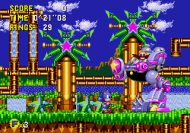
One of the essential elements that make the Sonic CD experience unique is the use of the time travel mechanic. For the first two Zones in each Round, four different time periods can be visited: the Present, the Past, and two different Futures - Good and Bad. Always starting in the Present time zone, the player can make Sonic jump between the Past and the Future by running across "Time Warp" plates, adorned with the word "Past" or "Future". Each of the four potential time periods one can jump to feature completely new art reflecting where Sonic is, with subtle changes in the layout. What may work as a quick way to blast through a Zone in the Present may be entirely impossible to get through in the Past, and vice versa.
These permutations in level design reflect on the way the levels are built in Sonic CD, for while the player can storm through a level for the fastest time possible, the multi-layer design can force the player to explore every nook and cranny within, not just for secret rooms and item boxes, but for items that can change the way a level works.
Located somewhere in each version of the Past for the first two Zones of any given Round is something known only as the robot transporter, the tool for which Dr. Eggman harvests the magical flower seeds of Little Planet and uses them to fuel his Badnik army. Though they can be found in the Present and Bad Future, they are nothing more than broken husks that have already done their job, Sonic unable to interact with them. In the Past, however, the machine is still fully functioning, and if Sonic is able to locate and destroy it, the Badniks within the Zone will cease to be, immediately breaking apart and letting the seeds go free, planting flowers that adorn Sonic's path through the level. It is only by destroying this machine that a "Good Future" can be obtained in the Zone; a cheery, pastel version as opposed to the dark and bleak mechanical form that composes the "Bad Future", which appears if the player ignores the robot-making machine.
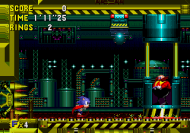
For the third Zone in each Round, Sonic automatically begins in the Future, with no "Time Warp" plates on the field. Which version of the future Sonic begins in depends on the actions of the player during the preceding two Zones. If both of Eggman's machines were located and destroyed, the boss encounter will happen in the "Good Future", while if neither or only one was found, then the fight will happen in the "Bad Future". Though Eggman's boss robots may look different depending on which future the player gets, the actual fight remains the same.
The Badnik army that fills each Zone is also affected by any given time frame Sonic is within. In the Present, the robots that Eggman has created have already been in operation for some time, and while most will function just like new, occasionally a broken down one will be found, with its look and attack pattern slightly modified, generally being an easier enemy to overcome. In the "Bad Future", the run-down versions are the only ones populating the area. In the Past, each robot is shiny and new, as they are still being created. However, if Eggman's robot-making machine is destroyed and Sonic ventures into the "Good Future", not a single Badnik will be seen, only the naturally occurring traps such as spikes being in his way to winning the level.
Within the game, there are not just one but two different ways to achieve the "good ending". The first is by going through and destroying each of Eggman's machines (fourteen in total) and making a "Good Future" for each Round. The second is by collecting all seven Time Stones, which are accessible in yet another version of the classic Special Stage. Just as in the first Sonic the Hedgehog, access to the Special Stage is granted by finishing a Zone with fifty Rings and jumping into the Giant Ring to the right of the signpost.
Using a pseudo-Mode 7 effect and showcasing the power of the Mega-CD, the goal is to destroy all of the UFOs flying about in the level before time runs out. When the counter goes down to 20 seconds, an extra blue UFO will appear, which will give Sonic extra time to finish the level if he can destroy it. If all seven Time Stones are collected, the good ending and its related animated winning sequence will appear, regardless of how many Eggman's machines were destroyed during the game.
Another destroyable item hidden in each of the past variants of the first two Zones of a Round (except in the final level) are projectors featuring the image of Metal Sonic tormenting the animals found in the classic games. Putting an end to his holographic reign of terror will cause the animals to be free, populating the rest of the Zone. Though not necessary for either ending, if one goes through and finds all twelve, a message touting the status of a super player will be shown after the end credits.
Time Attack
A new mode introduced in Sonic the Hedgehog CD, Time Attack is as the name implies, giving the player the option to run through any particular Zone as fast as possible, the best times being recorded in the Mega-CD's RAM for posterity. Once a level has been completed in the main game, it becomes available in the Time Attack screen, though only the "Present" version of Zone's 1 and 2 are accessible, with each field stripped of its Time Warp posts. Though basic enough, the mode serves an important purpose, offering up a collection of bonus features to be unlocked if the total time for all Zones is under a certain point:
- Under 37'27"57: "D.A. Garden" is unlocked on the title screen, allowing a sound test with a Little Planet background, accompanied by animations of Tails, Dr. Eggman, and Metal Sonic.
- Under 30'21"05: Time Attack for the Special Stages is added.
- Under 25'46"12: "Visual Mode" is unlocked on the title screen, allowing the intro, both endings, and a pencil test to be viewed at the player's leisure.
Scoring
Note: Scoring 50,000 points will grant the player an extra life
Hitting Bumpers: 100 points each for the first five hits on any given bumper; after that no more points can be gained from that bumper
Glass Bumpers: 100
Enemy Chains:
- First Enemy = 100
- Second Enemy = 200
- Third Enemy = 300
- Fourth and all Subsequent Enemies = 1,000 each
Robot transporters: 1,500
Dr. Eggman Boss: 1,000
End Level Ring Bonus: 100 points for each Ring held
End Level Time Bonus:
- 0'29"99 or less = 50,000
- 0'30"99 to 0:44"99 = 10,000
- 0'45"99 to 0'59"99 = 5,000
- 1'00"99 to 1'29"99 = 4,000
- 1'30"99 to 1'59"99 = 3,000
- 2'00"99 to 2'59"99 = 2,000
- 3'00"99 to 3'59"99 = 1,000
- 4'00"99 to 4'59"99 = 500
- 5'00"99 or more = 0
Special Stage:
- Rings = Total Collected multiplied by 200
- Time Bonus = Seconds Remaining multiplied by 200
Audio
File:StHR CD JP booklet.pdf Because of the game's presentation on then-cutting age digital media, Sonic CD was the first in the series to take full advantage of high quality, Redbook audio. Naofumi Hataya and Masafumi Ogata were the ones responsible for the soundtrack, creating a basic theme for the "present" levels and then remixing them for the "past," "good future" and "bad future" variants, altering the mood to reflect on where Sonic was now running but maintaining the basic elements of the core theme. Though most of the songs are done in Redbook format, each "past" track is done in PCM format, similar to the style in the Mega Drive games. The vocal themes were sung by J-pop artist Keiko Utoku, while the tracks for the levels used numerous samples to give them a richer sound. The best example of this technique is with the music that plays during each standard boss encounter, which samples Bob Marley's "Sun is Shining (Funkstar Remix)", Hall & Oates' "I Can't Go for That(No Can Do)" and "Work That Sucker To Death" by Xavier.
Though the original soundtrack was maintained in the European release, Sega of America decided to redo the majority of the soundtrack, having in-house musicians Spencer Nilsen and David Young compose the new themes. Instead of having two separate tracks for the intro and ending, only one was composed, Sonic Boom, an up-tempo version greeting those playing the American version and a slower rock remix accompanying the credits. The only tracks in the original version that were left untouched were the "past" mixes, as they had been programmed into the game and would require a greater amount of effort to change than simply replacing one set of Redbook audio files with another.
The music for the Spencer Nilsen tracks was the first to be given the soundtrack release treatment, a majority of the songs appearing on the full-length album Sonic the Hedgehog Boom, which was only available for those who had preordered Sonic the Hedgehog 3 in the west. The same year, Hataya and Ogata revisited the music they had done for the game, remixing the songs once again for the appropriately named Sonic the Hedgehog - Remix, only available in Japan. It would not be until 2011 when the original compositions would be released on both CD and digital venues.
Sound test
Below is a listing of the songs available to be played through the sound test within the game. The names attributed to each file are those presented in the unlockable "D.A. Garden" mode ("Sound Test" in the U.S. edition), while the associated letter/number listings are how they are presented in the secret sound test.
- DA No. 00: Palmtree Panic
- DA No. 01: Palmtree Panic "G" mix
- DA No. 02: Palmtree Panic "B" mix
- DA No. 03: Collision Chaos
- DA No. 04: Collision Chaos "G" mix
- DA No. 05: Collision Chaos "B" mix
- DA No. 06: Tidal Tempest
- DA No. 07: Tidal Tempest "G" mix
- DA No. 08: Tidal Tempest "B" mix
- DA No. 09: Quartz Quadrant
- DA No. 10: Quartz Quadrant "G" mix
- DA No. 11: Quartz Quadrant "B" mix
- DA No. 12: Wacky Workbench
- DA No. 13: Wacky Workbench "G" mix
- DA No. 14: Wacky Workbench "B" mix
- DA No. 15: Stardust Speedway
- DA No. 16: Stardust Speedway "G" mix
- DA No. 17: Stardust Speedway "B" mix
- DA No. 18: Metallic Madness
- DA No. 19: Metallic Madness "G" mix
- DA No. 20: Metallic Madness "B" mix
- DA No. 21: Boss!!
- DA No. 22: Final Fever
- DA No. 23: Title
- DA No. 24: Time Attack Menu
- DA No. 25: Zone Clear
- DA No. 26: Speed Up!!
- DA No. 27: Invincible!!
- DA No. 28: Game Over
- DA No. 29: Special Stage
- DA No. 30: Little Planet
- DA No. 31: Unused Warp Sound
- DA No. 32: Sonic - You Can Do Anything/Sonic Boom (Intro)
- DA No. 33: Cosmic Eternity - Believe in Yourself/Sonic Boom (Ending)
- PCM No. 10: Palmtree Panic "P" mix
- PCM No. 11: Collision Chaos "P" mix
- PCM No. 12: Tidal Tempest "P" mix
- PCM No. 13: Quartz Quadrant "P" mix
- PCM No. 14: Wacky Workbench "P" mix
- PCM No. 15: Stardust Speedway "P" mix
- PCM No. 16: Metallic Madness "P" mix
Voice actors
| Role | Voice Actor |
|---|---|
| Sonic the Hedgehog | Masato Nishimura |
| Amy Rose | Lynn Harris |
Comparisons
| |
Main article: Sonic the Hedgehog CD/Comparisons |
History
Legacy
In addition to the alternate music found in the American version of Sonic CD, the song that plays during the famous race between Sonic and Metal Sonic is always the "bad future" mix, even if a good future has been achieved.
Windows PC version
Following its Mega-CD release, a deal was made between Sega and Intel Corporation. At the time, Intel were looking to demonstrate that similar performance to video game consoles could be acheived on Pentium-class PCs running Windows 95; it was feasible in MS-DOS (with limits), but not Windows, and Intel wanted to "fix" this[15].
However, Sonic CD, written in M68000 assembler for the Mega-CD, would have to be ported to C to ensure compatiblity. A team was therefore put together to port and re-create a Mega Drive-style interface in which Sonic CD could then use; this set of libraries was collectively known as "Dino" (later "RDX", the "Realistic Display miXer" for graphics abstraction Intel RDX Whitepaper and "RSX", the "Realistic Sound Experience" for audio.). Sonic CD was written prior to Microsoft's launch of DirectX, which would become a de facto standard for producing Windows PC games in the years that followed, and was distributed exclusively in PC bundles (namely those provided by the likes of Packard Bell and Hewlett-Packard) as a piece of OEM software.
Roughly 5 million "Dino" copies of Sonic CD were produced[15]. Later the game was ported to DirectX and shipped as a stand-alone game by Sega, removing the Intel credits and becoming the version of choice for re-releases that followed.
When the game was ported to the PC on the Windows 95 platform in 1996, the Spencer Nilsen soundtrack was used in every region, including Japan, and featured the "past" mixes of each song converted into Redbook audio format as well. The save feature was also redone, allowing multiple files to exist at once. As for the opening and closing FMV sequences, the expanded power of the home computer allowed the full versions of these animations to be seen for the first time, with detail the limited color palette of the Mega-CD was unable to handle.
Later versions
The PC port of the game was used as the basis for the version of Sonic CD used in the compilation title Sonic Gems Collection, and because of this met with its own changes and flaws. While the original soundtrack was maintained in the Japanese release of the game, the American soundtrack was used in the European release, which had not been done in the original Mega-CD version. The water effects in Tidal Tempest were nerfed, the water being clear as opposed to the green shade in the regular version. The entire credits sequence was omitted, the ending FMV filling the entire screen instead. Finally, in the Nintendo GameCube version of the port, the Debug Mode game cheat was only half-enabled, the ability to place objects impossible due to one of the keys not being mapped to the GameCube's controller.
Most recently, the 2011 multi-platform release of Sonic CD has alterations both small and large, thanks in part to being a remake as opposed to being emulated. Among the features of the game is the ability to choose between the Japanese and American soundtracks, the music fully looping as it no longer is confined by the CD format, having the choice between the Sonic CD spin dash and the more common variant found in Sonic 2, and having Miles "Tails" Prower as an unlockable character.
Re-releases
- Sonic the Hedgehog CD for PC (1996)
- Sega Family Fun Pak for PC (1996)
- Sonic & Garfield Pack for PC (1999)
- Sonic Action Pack for PC (2000)
- Sonic Action 4 Pack for PC (2001)
- Twin Pack: Sonic CD and Sonic & Knuckles Collection for PC (2002)
- Sega PC Mega Pack for PC (2003)
- Sonic Gems Collection for Nintendo GameCube and PlayStation 2 (2005)
- Sonic the Hedgehog CD for Xbox 360, PlayStation 3, iOS, and Android (2011); later Steam (2012)
- Sonic Origins for PlayStation 4, PlayStation 5, Xbox One, Xbox Series X, Nintendo Switch, Steam and Epic Games Store (2022)
- Mega Drive Mini 2 (2022)
Adaptations
In an attempt to advertise Sonic the Hedgehog CD and its later PC port, various comic book adaptations were commissioned within the pages of the two Sonic the Hedgehog comic book titles running at the time. In the United States, the Archie Comics series Sonic the Hedgehog used its 25th issue to adapt the game, merging elements of the game's plot (such as the kidnapping of Amy Rose and the race with Metal Sonic) into its Saturday morning-inspired universe. In the United Kingdom series Sonic the Comic published by Fleetway, the adaptation to the game spanned multiple issues, starting in number 24 and continuing through 28. While the first two parts of the tale were based in Sonic the Comic-specific characters, the later parts of "The Sonic Terminator" featured Metal Sonic (called "Metallix" in the series) kidnapping Amy Rose and taking her to the Little Planet, where Sonic was forced to battle his double through time.
Production credits
| |
Main article: sega:Sonic the Hedgehog CD/Production credits |
Manuals
| |
Main article: Sonic the Hedgehog CD/Manuals |
Promotional material
| |
Main article: Sonic the Hedgehog CD/Promotional material |
Artwork
Physical scans
Mega-CD version
| 93 | Sonic Retro Average | |||||||||||||||||||
|---|---|---|---|---|---|---|---|---|---|---|---|---|---|---|---|---|---|---|---|---|
| Based on 5 reviews | ||||||||||||||||||||
| ||||||||||||||||||||
| Mega-CD, JP |
|---|
| Mega-CD, US |
|---|
| Mega-CD, US (bundle) |
|---|
| |
| Mega-CD, EU |
|---|
| Mega-CD, PT |
|---|
| Mega-CD, BR |
|---|
PC version
| PC, US (Dino) |
|---|
|
|
| |
| PC, (Expert Software; T-6805-01 01) |
|---|
| PC, US (Expert Software; T-6805-02 02) |
|---|
|
|
| PC, US (Expert Software; T-6805-03 02) |
|---|
| PC, US (Expert Software; T-6805-03 03) |
|---|
|
|
| PC, EU |
|---|
| PC, AU |
|---|
| PC, BR (Dino) |
|---|
|
|
| PC, BR (DirectX) |
|---|
|
|
Download
| Download Sonic the Hedgehog CD
File: SonicCD Demo.7z (4.52 MB) (info)
|
Technical information
ROM dump status
| System | Hash | Size | Build Date | Source | Comments | |||||||||
|---|---|---|---|---|---|---|---|---|---|---|---|---|---|---|
| ? |
|
1993-08-06 | CD-ROM (JP) | |||||||||||
| ? |
|
1993-08-27 | CD-ROM (EU) | |||||||||||
| ? |
|
1993-10-12 | CD-ROM (US) | |||||||||||
| ✔ |
|
1992-12-04 | CD-R[16] | v0.02 | Page | |||||||||
| ✘ |
|
1993-05-10 | CD-R | "510" | Page | |||||||||
| ✔ |
|
1993-05-12 | CD-R[17] | v0.28A | Page | |||||||||
| ✔ |
|
1993-06-21 | CD-R[18] | v0.51 | Page | |||||||||
| ✘ |
|
1993-07-12 | CD-R[19] | v0.70 (first copy) | Page | |||||||||
| ✔ |
|
1993-07-12 | CD-R[20] | v0.70 (second copy) | Page | |||||||||
| ✔ |
|
1993-08-01 | CD-R[21] | v1.05 | Page | |||||||||
| ✔ |
|
1993-08-06 | CD-R[22] | JP demo | Page | |||||||||
| ✔ |
|
1993-08-06 | CD-R[23] | v1.09 (PAL prerelease) | Page | |||||||||
| ✔ |
|
1993-08-19 | CD-R[24] | v1.11 (PAL prerelease) | Page | |||||||||
| ✔ |
|
1993-09-20 | CD-R[25] | "920" (US prerelease with JP soundtrack) | Page | |||||||||
| ✔ |
|
1993-10-13 | CD-R[26] | v1.15 (US prerelease) | Page | |||||||||
| ? |
|
1995-09-07 | CD-R | Beta v0.992 | Page | |||||||||
| ? |
|
1995-09-14 | CD-R | Beta v0.994 | Page |
Sonic CD PC Patch
- Sonic CD patch (info) (286 kB) for Windows XP and later - A patch created by community member Korama to allow the 1996 PC version of Sonic CD to work on modern computer machines.[27] It is important to note this patch is not compatible with the DINO release.
Hacking guides
External links
- Sega of America webpage: PC
- Official version of the game (US): Sonic CD ROM
- Sonic the Hedgehog CD on Zone: 0
- Sonic the Hedgehog CD on The Green Hill Zone
- Sonic the Hedgehog CD on Zone: 0
References
- ↑ based on producer Makoto Oshitani and other confirmed CS3 staff members
- ↑ @SiFi_TZK on Twitter (Wayback Machine: 2023-09-16 20:17)
- ↑ based on producer Minoru Kanari
- ↑ 4.0 4.1 https://sega.jp/history/hard/mega-cd/software.html (Wayback Machine: 2020-06-22 19:24)
- ↑ [gamepro, issue 54, page 68 gamepro, issue 54, page 68]
- ↑ [Sunday Mirror, issue 1993-11-21, page 14 Sunday Mirror, issue 1993-11-21, page 14]
- ↑ [mega, issue 13, page 23 mega, issue 13, page 23]
- ↑ [megapower, issue 7, page 80 megapower, issue 7, page 80]
- ↑ 9.0 9.1 [videogames, issue 1993-09, page 43 videogames, issue 1993-09, page 43]
- ↑ [mz, issue 35, page 27 mz, issue 35, page 27]
- ↑ 11.0 11.1 http://sega.jp/pc/soniccd/ (Wayback Machine: 2001-11-02 15:28)
- ↑ 12.0 12.1 Press release: 1997-06-20: Sega chooses Expert Software for PC distribution agreement
- ↑ [bemega, issue 1993-10, page 118 bemega, issue 1993-10, page 118]
- ↑ http://shmuplations.com/soniccd/ (Wayback Machine: 2020-03-24 22:50)
- ↑ 15.0 15.1 Jim Tretheway interview by RyogaMasaki (September 2000)
- ↑ http://forumsx.sonic-cult.org/index.php?showtopic=6039 (Wayback Machine: 2007-11-03 14:34)
| Sonic the Hedgehog CD | |
|---|---|
|
Main page (2011) Manuals |
show;hide
Scrapped Enemies: Scrapped Bosses: Mega-CD: Windows PC:
Books:
Music: |
| Sonic the Hedgehog games for the following systems | |
|---|---|
| |
1991 Sonic the Hedgehog | Sonic Eraser 1992 Sonic the Hedgehog 2 1993 Sonic the Hedgehog CD | Dr. Robotnik's Mean Bean Machine | Sonic Spinball 1994 Sonic the Hedgehog 3 | Sonic & Knuckles 1995 Chaotix | Sonic Classics 1996 Sonic 3D: Flickies' Island |
